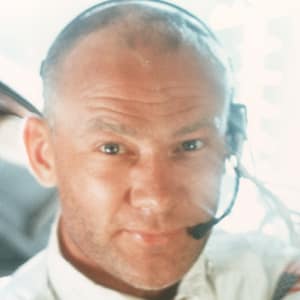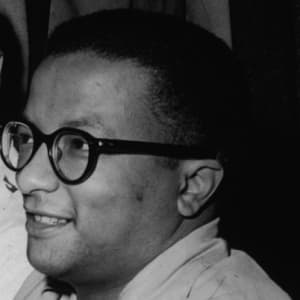
Buzz Aldrin
Astronaut Buzz Aldrin was one of the first people to walk on the moon. He and flight commander Neil Armstrong made the Apollo 11 moonwalk in 1969.
Who Is Buzz Aldrin?
Buzz Aldrin was born on January 20, 1930, in Montclair, New Jersey. His father, a colonel in the U.S. Air Force, encouraged his interest in flight. Aldrin became a fighter pilot and flew in the Korean War. In 1963 he was selected by NASA for the next Gemini mission. In 1969, Aldrin, along with Neil Armstrong, made history when they walked on the moon as part of the Apollo 11 mission. Aldrin later worked to develop space-faring technology and became an author, writing several sci-fi novels, children's books, and memoirs including Return to Earth (1973), Magnificent Desolation (2009) and No Dream Is Too High: Life Lessons From a Man Who Walked on the Moon (2016).
Books
In his later career, Aldrin became a prolific author. In addition to his first autobiography Return to Earth, he wrote Magnificent Desolation, a memoir that hit bookshelves in 2009 — just in time for the 40th anniversary of his historic moon landing. He has also written several children's books, including Reaching for the Moon (2005), Look to the Stars (2009) and Welcome to Mars: Making a Home on the Red Planet (2015); science-fiction novels including The Return (2000) and Encounter with Tiber (2004), co-authored with John Barnes; and Men from Earth (1989), a historical account of the lunar landing. He released the memoir No Dream Is Too High: Life Lessons From a Man Who Walked on the Moon in 2016.
Early Life
Famed astronaut Buzz Aldrin was born Edwin Eugene Aldrin Jr. on January 20, 1930 in Montclair, New Jersey. He earned his nickname, "Buzz," as a child when his little sister mispronounced the word "brother" as "buzzer. His family shortened the nickname to "Buzz." Aldrin would make it his legal first name in 1988.
His mother, Marion Moon, was the daughter of an Army chaplain. His father, Edwin Eugene Aldrin, was a colonel in the U.S. Air Force. In 1947, Buzz graduated from Montclair High School in Montclair, New Jersey, and headed to the U.S. Military Academy at West Point. He took well to the discipline and strict regimens, and was the first in his class his freshman year. He graduated third in his class in 1951 with a B.S. in mechanical engineering.
Military Career
Aldrin's father felt his son should continue on to multi-engine flight school so that he could eventually take charge of his own flight crew, but Buzz wanted to become a fighter pilot. His father relented to his son's wishes, and after a summer of hitching around Europe on military planes, Buzz officially entered the United States Air Force in 1951. He again scored near the top of his class in flight school, and began fighter training later that year.
During his time in the military, Aldrin joined the 51st Fighter Wing, where he flew F-86 Sabre Jets in 66 combat missions in Korea. During the Korean War, F-86 planes fought to defend South Korea from the invasion of Communist forces in North Korea. Aldrin's wing was responsible for breaking the enemy "kills" record during combat, when they shot down 61 enemy MIGs and grounded 57 others in one month of combat. Aldrin shot down two MIG-15s, and was decorated with the Distinguished Flying Cross for his service during the war.
After a cease-fire was declared between North and South Korea in 1953, Aldrin returned home. He pursued higher education at the Massachusetts Institute of Technology where he planned to complete a master's degree and then apply for test pilot school. Instead, he earned a Ph.D. in aeronautics and astronautics, graduating in 1963. His thesis subject "Line-of-sight guidance techniques for manned orbital rendezvous" was the study of bringing piloted spacecraft into close proximity with each other.
Space Flight
His specialized study of rendezvous helped to earn him entry into the space program shortly after graduation. In 1963, Aldrin was part of a third group of men selected by NASA to attempt to pioneer space flight. He was the first astronaut with a doctorate and because of his expertise he earned the nickname "Dr. Rendezvous." Aldrin was put in charge of creating docking and rendezvous techniques for spacecraft. He also pioneered underwater training techniques to simulate spacewalking.
In 1966, Aldrin and astronaut Jim Lovell were assigned to the Gemini 12 crew. During their November 11 to November 15, 1966, space flight, Aldrin made a five-hour spacewalk — the longest and most successful spacewalk ever completed at that time. He also used his rendezvous abilities to manually recalculate all the docking maneuvers on the flight, after the on-board radar failed. He also took a photograph of himself, which would later be called the first "selfie" in space, on that mission.
After Gemini 12, Aldrin was assigned to the back-up crew of Apollo 8 along with Neil Armstrong and Harrison "Jack" Schmitt. For the historic Apollo 11 lunar landing mission, Aldrin served as the lunar module pilot. On July 20, 1969, he made history as the second man to walk on the moon, following mission commander Armstrong, who took the first step on the lunar surface. They spent a total of 21 hours during the moonwalk, and returned with 46 pounds of moon rocks. The walk, which was televised, drew an estimated 600 million people to watch, becoming the world's largest television audience in history.
Upon their safe return to Earth, Aldrin was decorated with the Presidential Medal of Freedom, followed by a 45-day international goodwill tour. Other honors include having Asteroid “6470 Aldrin” and the “Aldrin Crater” on the moon named after him. Aldrin and his Apollo 11 crew mates Neil Armstrong and Michael Collins also received the Congressional Gold Medal in 2011, and the Apollo 11 crew were honored with four stars on the Hollywood Walk of Fame in California.
Later Career
In March 1972, after 21 years of service, Aldrin retired from active duty and returned to the Air Force in a managerial role. He later revealed in his 1973 autobiography, Return to Earth, that he battled depression and alcoholism following his years with NASA, leading to a divorce.
After rediscovering sobriety, Aldrin turned to studying advancements in space technology. He devised a spacecraft system for missions to Mars known as the "Aldrin Mars Cycler," and received three U.S. patents for his schematics of a modular space station, Starbooster reusable rockets, and multi-crew modules.
He also founded ShareSpace Foundation, a nonprofit organization devoted to advancing space education, exploration and affordable space flight experiences. In 2014, he revamped the nonprofit to focus on STEAM Education (Science, Technology, Engineering, Arts and Math) to inspire children from kindergarten through 8th grade to learn about space.
In August 2015, he launched the Buzz Aldrin Space Institute at Florida Tech “to promote and develop his vision of a permanent human settlement on the planet Mars,” according to his official website.
Aldrin also continued to give lectures and make television appearances, including competing on Dancing with the Stars in 2010, where he showed the world that a senior astronaut still had some impressive moves. He also made guest appearances on The Simpsons, 30 Rock, and The Big Bang Theory, and had a cameo in the movie Transformers: Dark of the Moon (2011).
Additionally, the iconic astronaut collaborated with hip-hop artists Snoop Dogg and Talib Kweli to create the song "Rocket Experience" to promote space exploration to young people. Proceeds from the sale of the song and video, which features music producer Quincy Jones and rapper Soulja Boy, benefit ShareSpace.
In November 2016, Aldrin was on a tourist trip to Antartica when he had to be medically evacuated to be treated at a hospital in New Zealand. A statement on his website said he was in stable condition with "fluid in his lungs," but in good spirits and responding well to antibiotics.
In April 2018, the U.K.'s Daily Star reported that Aldrin had submitted to an advanced technology lie detector test, which determined he was telling the truth when recalling how he saw a possible UFO during the famed Apollo 11 trip in 1969. Stories of Aldrin's supposed encounter had served as a touchstone for alien truthers for years, but the man himself squashed the rumors through his spokesperson, calling them "fabrication for the sake of headlines."
That June, Aldrin filed a lawsuit against two of his children, Andrew and Jan Aldrin, along with his business manager, Christina Korp, alleging elder and financial exploitation. The following month, he was a surprise no-show at the Apollo gala that commenced a year-long anniversary of the first moon landing, despite the event being sponsored by ShareSpace. No reason was initially given for his absence.
Personal Life
Aldrin has been married three times. He and his first wife, actress Joan Archer, had three children together — James, Janice and Andrew. His second wife was Beverly Zile. He married his third wife, Lois Driggs Cannon, on Valentine's Day in 1988. They divorced in 2012.
Related Videos
Neil Armstrong – Mini Biography(TV-14; 4:04)
Neil Armstrong – The 40th Anniversary of the Walk on the Moon(TV-14; 4:32)



